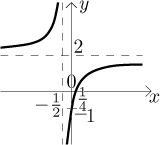Problem: Using the knowledge of transformations guess the graph of the following function:
![]()
Solution: First we need to identify the basic function whose shape we start with. However, this is not possible here, since the variable x is here twice. The guessing procedure always starts from some elementary function and in all of then the variable appears only once, transformations then do not allow to multiply its presence.
Fortunately for us, in this particular example there is a way out. We have a ratio of linear functions and this expression is usually much more user-friendly when divided with remainder, we actually use our favorite trick instead and create the denominator in the numerator. First we fix the correct quantity of x by multiplying/dividing, then we fix the absolute term by adding/substracting.

We made the very last step to prepare the expression for analysis. Now we
have just one x and we are ready to identify the basic function.
First, we know that the expression in the denominator can be created using
shift and scaling, so we can disregard it and only consider
So we start with the graph of the function
x → x + 1 → (2x) + 1.
In each step we replaced x itself by the corresponding transformed expression and obtained what we need, so the order is correct. Let's do it.

Quick check that we did not make any major mistake so far: There is a hole in
the domain at
Now it is time to apply transformations to the value. There are two, scaling
by

That should be it. However, we recommend that two more things be done.
First, we check that the graph we guessed is not completely off by
calculating major features. There are two very prominent features, the
vertical and horizontal asymptote. The vertical asymptote is at the hole in
the domain
Then we look at the limit of the function at infinity and negative infinity and obtain 2 (again, this is easy just by looking at the expression), so we got the horizontal asymptote right as well. We can now be quite confident that we guessed it well.
Now the second thing.
The guessing procedure is quite reliable in the hands of an experienced
student, so if we have a nice and correct graph, it might be worthwile to
made little adjustments to the graph to also capture further information
correctly. There are two very prominent points, the intercepts. So we
calculate the y-intercept:
